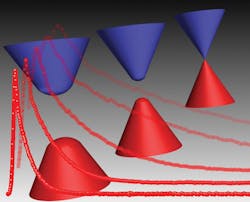Nonlinear Optical Materials: 3D Dirac semimetal to ignite mid-IR ultrafast photonics
Mid-infrared (mid-IR) short-pulsed lasers are key enabling components for numerous applications, including free-space communications, imaging, biomedical sensing, and spectroscopy. And while quantum-cascade lasers (QCLs) have been successfully developed to meet some of the technical needs for mid-IR applications, the realization of ultrashort-pulsed operation in this span remains a challenge—largely because of the absence of functional ultrafast optical switches (or saturable absorbers) in the mid-IR region.
Semiconductor saturable-absorber mirrors (SESAMs)—a technological breakthrough in ultrafast photonics in the 1990s—are widely used to generate ultrafast laser pulses. A compelling advantage of SESAMs is that key optical parameters can be flexibly customized through precise engineering of material compositions or device structures. However, most SESAMs operate only in the near-IR window.
Building on initial research in the development of graphene saturable absorbers operating at around 2 μm, researchers at Nanjing University (Nanjing, China) are now looking to three-dimensional (3D) Dirac semimetals to enable ultrafast lasers operating at 3 μm and even up to 6 μm wavelengths.1
Beyond graphene
In the past decade, low-dimensional materials, including carbon nanotubes, graphene, and, more recently, narrow-bandgap two-dimensional materials such as black phosphorus, have been considered as low-cost and broadband alternatives for SESAMs. However, the defect-prone nature of these materials makes it difficult to tune their intrinsic nonlinear optical response, and also leads to poor repeatability and reliability.
"Graphene eventually reaches a bottleneck in that its nonlinear optical features are not easily altered or controlled to reach farther out in the mid-IR," says Fengqiu (Frank) Wang, part of the Cambridge University team that developed 2 μm graphene saturable absorbers and now a key researcher at Nanjing University whose team was the first to get graphene to mode-lock at 3 μm. "Unfortunately for graphene, its electron-hole recombination process [or switching time] makes wide tunability difficult—a drawback that led us to explore alternative nonlinear materials."
It turns out that a 3D Dirac semimetal—sometimes referred to as "3D graphene" because of the graphene-like Dirac cone in its band structure—has all the benefits of graphene, but also offers a switching time that is tunable over a range of 1 to 10 ps, which is highly relevant for developing mid-IR pulsed lasers.
More specifically, Wang and colleagues developed molecular beam epitaxy (MBE)-grown cadmium arsenide (Cd3As2), a 3D Dirac semimetal whereby flexible tuning of the photocarrier recovery time is achieved by a chromium (Cr) doping approach similar to highly adaptable near-IR SESAMs (see figure).
In proof-of-concept experiments using Cd3As2 films with different relaxation times as a result of different Cr doping levels, on-demand demonstration of different short-pulse regimes (mode-locked or Q-switched) was demonstrated in a mid-IR fluoride laser. The researchers say that this nonlinear Dirac semimetal paves the way for the realization of compact and efficient pulsed lasers, including passively mode-locked QCLs operating from 3 to 5 μm.
REFERENCE
1. C. Zhu et al., NatureCommun., 8, 14111 (2017); doi:10.1038/ncomms14111.

Gail Overton | Senior Editor (2004-2020)
Gail has more than 30 years of engineering, marketing, product management, and editorial experience in the photonics and optical communications industry. Before joining the staff at Laser Focus World in 2004, she held many product management and product marketing roles in the fiber-optics industry, most notably at Hughes (El Segundo, CA), GTE Labs (Waltham, MA), Corning (Corning, NY), Photon Kinetics (Beaverton, OR), and Newport Corporation (Irvine, CA). During her marketing career, Gail published articles in WDM Solutions and Sensors magazine and traveled internationally to conduct product and sales training. Gail received her BS degree in physics, with an emphasis in optics, from San Diego State University in San Diego, CA in May 1986.
